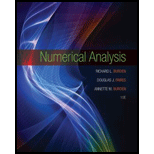
Numerical Analysis
10th Edition
ISBN: 9781305253667
Author: Richard L. Burden, J. Douglas Faires, Annette M. Burden
Publisher: Cengage Learning
expand_more
expand_more
format_list_bulleted
Concept explainers
Question
error_outline
This textbook solution is under construction.
Students have asked these similar questions
6 (Model Selection, Estimation and Prediction of GARCH) Consider the daily returns rt
of General Electric Company stock (ticker: "GE") from "2021-01-01" to "2024-03-31",
comprising a total of 813 daily returns. Using the "fGarch" package of R, outputs of
fitting three GARCH models to the returns are given at the end of this question.
Model 1 ARCH (1) with standard normal innovations;
Model 2
Model 3
GARCH (1, 1) with Student-t innovations;
GARCH (2, 2) with Student-t innovations;
Based on the outputs, answer the following questions.
(a) What can be inferred from the Standardized Residual Tests conducted on Model 1?
(b) Which model do you recommend for prediction between Model 2 and Model 3?
Why?
(c) Write down the fitted model for the model that you recommended in Part (b).
(d) Using the model recommended in Part (b), predict the conditional volatility in the
next trading day, specifically trading day 814.
4 (MLE of ARCH) Suppose rt follows ARCH(2) with E(rt) = 0,
rt = ut, ut =
στει, σε
where {+} is a sequence of independent and identically distributed (iid) standard normal
random variables.
With observations r₁,...,, write down the log-likelihood function for the model esti-
mation.
5 (Moments of GARCH) For the GARCH(2,2) model rt =
0.2+0.25u1+0.05u-2 +0.30% / -1 +0.20% -2, find cov(rt).
0.0035 ut, ut =
στει,στ
=
Knowledge Booster
Learn more about
Need a deep-dive on the concept behind this application? Look no further. Learn more about this topic, subject and related others by exploring similar questions and additional content below.Similar questions
- (14 points) Let S = {(x, y, z) | z = e−(x²+y²), x² + y² ≤ 1}. The surface is the graph of ze(+2) sitting over the unit disk.arrow_forwardDoor 87.5in to 47 living 44.75 Closet 96in Window ISS.Sin 48in Train Table 96in 48in 132:2 Windowarrow_forwardClassify the singularities for the following functions at the given point. at a = (a) f(z) = 1 (2 sin z-1)² (b) f(z) = exp(4)-1 at 0 and at a = (c) f(z) = 1-cosh z at a=0 2 In the case of a pole, indicate the order of the pole and its residue.arrow_forward
- Definition of null hypothesis from the textbook Definition of alternative hypothesis from the textbook Imagine this: you suspect your beloved Chicken McNugget is shrinking. Inflation is hitting everything else, so why not the humble nugget too, right? But your sibling thinks you’re just being dramatic—maybe you’re just extra hungry today. Determined to prove them wrong, you take matters (and nuggets) into your own hands. You march into McDonald’s, get two 20-piece boxes, and head home like a scientist on a mission. Now, before you start weighing each nugget like they’re precious gold nuggets, let’s talk hypotheses. The average weight of nuggets as mentioned on the box is 16 g each. Develop your null and alternative hypotheses separately. Next, you weigh each nugget with the precision of a jeweler and find they average out to 15.5 grams. You also conduct a statistical analysis, and the p-value turns out to be 0.01. Based on this information, answer the following questions. (Remember,…arrow_forwardBusiness Discussarrow_forwardDetermine all functions f analytic in the open unit disc || < 1 which satisfy in addition f(0) = 1 and |f(z)|≥ 1 whenever || < 1. Justify your answer.arrow_forward
- Deduce the Laurent expansion for f(z) = 22(2-3)2 in the annulus 0 < |z3|< 3.arrow_forwardWhat can you conclude about a complex-valued function f(z) that satisfies 1. f is complex differentiable everywhere 2. ƒ(z+1) = ƒ(z) for all z 3. For a fixed complex number a with nonzero imaginary part, f(z+a) = f(z) for all z ? Justify your answer. (Hint: Use Liouville's theorem.)arrow_forward6. Solve the system of differential equations using Laplace Transforms: x(t) = 3x₁ (t) + 4x2(t) x(t) = -4x₁(t) + 3x2(t) x₁(0) = 1,x2(0) = 0arrow_forward
- 3. Determine the Laplace Transform for the following functions. Show all of your work: 1-t, 0 ≤t<3 a. e(t) = t2, 3≤t<5 4, t≥ 5 b. f(t) = f(tt)e-3(-) cos 4τ drarrow_forward4. Find the inverse Laplace Transform Show all of your work: a. F(s) = = 2s-3 (s²-10s+61)(5-3) se-2s b. G(s) = (s+2)²arrow_forward1. Consider the differential equation, show all of your work: dy =(y2)(y+1) dx a. Determine the equilibrium solutions for the differential equation. b. Where is the differential equation increasing or decreasing? c. Where are the changes in concavity? d. Suppose that y(0)=0, what is the value of y as t goes to infinity?arrow_forward
arrow_back_ios
SEE MORE QUESTIONS
arrow_forward_ios
Recommended textbooks for you
 Elements Of Modern AlgebraAlgebraISBN:9781285463230Author:Gilbert, Linda, JimmiePublisher:Cengage Learning,
Elements Of Modern AlgebraAlgebraISBN:9781285463230Author:Gilbert, Linda, JimmiePublisher:Cengage Learning,

Elements Of Modern Algebra
Algebra
ISBN:9781285463230
Author:Gilbert, Linda, Jimmie
Publisher:Cengage Learning,
Definite Integral Calculus Examples, Integration - Basic Introduction, Practice Problems; Author: The Organic Chemistry Tutor;https://www.youtube.com/watch?v=rCWOdfQ3cwQ;License: Standard YouTube License, CC-BY